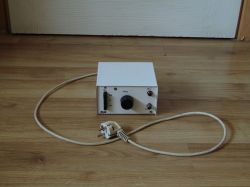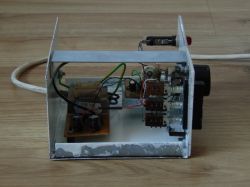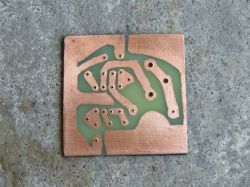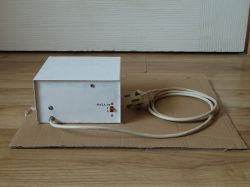A simple workshop generator m.cz.

Hello,
Necessity is the mother of invention, sometimes the right equipment is needed for servicing, such as a low-frequency signal generator used to repair amplifiers and receivers. There are a lot of devices on the market, both new and used, but their price is unacceptable to me. So I thought that in order to save costs I would build something like this. The choice fell on a simple sine wave generator with three frequencies: 100 Hz, 1 kHz and 10 kHz, powered from the 230 V mains. I found a description of the electronic circuit on the Internet. It comes from the popular magazine Elektronika Praktyczna 1/95.
The mechanical construction consists of a base made of steel sheet with two sides riveted to it. The lid is also cut from the same material. The metal pieces were cut with a hacksaw and then bent with a vice in my dad's garage. On it, the power supply is screwed with M3 screws through distance sleeves a few millimeters long. The front panel is made of plastic. On the latter, the so-called a small chassis with a generator board, a dependent isostat switch with frequency selection RC elements, a control lamp and a BNC output socket. The inscriptions were made with a thin waterproof marker. Before final assembly, the steel parts were painted with anti-corrosion paint. The box is permanently connected to the PE conductor of the power cable.
The modules on the boards are connected by thin wires. The power supply includes a TS2/14 domestically produced transformer and a rectifier with a Delon doubler equipped with two filtering capacitors. From it comes the DC voltage of approx. 14 V and the alternating voltage of approx. 11 V to power the control lamp with the telephone bulb. The boards were etched in a solution of sodium persulfate heated indirectly by solar energy, the process for the power supply circuit took about 40 minutes. The Wien bridge generator contains a double TL082 operational amplifier placed in a socket. The first stage produces a sinusoidal signal with the selected frequency, the second is a buffer. A 60V/20mA telephone bulb is used to stabilize the amplitude, and the Telpod CN-15 cermet potentiometer is used to set it. The signal is regulated by a Telpod SP 1.2 carbon potentiometer from zero to approx. 4 Vrms. On the back there is an output ground switch.
The approximate cost is a dozen zlotys and is low due to the use of recycled materials and parts, e.g. a three-core power cord with a plug is made of electronic scrap, the casing sheet was purchased at a local scrap yard, and the plastic is recycled. The rest of the used parts I had from my own stock. The elements that I bought myself are a mains transformer in a stationary store, two electrolytic capacitors (TME) low-SR Panasonic 470 uF/25 V/105 °C and a double operational amplifier TL082 (Allegro). Due to the shortage of some parts, work on this device took about one year.
I add some photos of the project:










Comments
The switch is visible in some photos, and in others it is not. BNC is also ordinary, not isolated, so it is at PE potential - the same as in most function generators. So what does this "output ground switch"... [Read more]
Hello, The switch is designed to break the ground loop when the output ground of the generator is connected with the tested circuit and the analog oscilloscope, in which its input socket is is permanent... [Read more]
Can you make some diagram because I don't understand. I have, perhaps mistakenly, the impression that the ground loop break is in the wrong place. [Read more]
And what about the mains fuse? [Read more]
Hello, Factory-made Polish devices with these transformers, e.g. power supplies for radio receivers or emergency lighting modules. they have no mains fuses on the mains supply side. So there is no need... [Read more]
And what happens if the transformer gets a short circuit of, say, 200 ohms and starts to heat up to the point where it can ignite? I still don't understand what the switch does. Can you make a d... [Read more]
I believe it cuts the PE wire from the mains cord from the housing. [Read more]
The front panel is made of plastic - it is non-conductive. Added after 1 [minutes]: I like. A reasonably maintained compromise of aesthetics to the amount of work. It is neat and looks decent. ... [Read more]
I don't know such a recipe... It would be very strange, besides it assumes that there will be no magical failure anywhere else in the device that could lead to a fire.. The fuse has two roles - protection... [Read more]
The author wrote: "The front panel is made of plastic." [Read more]
I'm honored, yes. I missed it. Still somehow I feel bad without a fuse ... Indeed, a wire in a tiny power transformer should not fall out of the transformer and strongly limits the current ... But... [Read more]
I'd probably give a fuse, just to feel good. Some time ago, an older colleague, a designer, told me about the "lack of its requirement" in small transformers, and it concerned certified medical equipment... [Read more]
Why this tension? Have you checked its characteristics for voltages equal to the amplitude present in the generator system? [Read more]
A board made of foamed PVC? As for the fuse - recently I have been resuscitating Carel controllers from Liebherr MediLine freezers. The controllers have a converter, which is an independent module on... [Read more]
Nice product. I made such products myself somewhere in the 80s, following the example of Maria and Wojciech Nowakowski's systems. All the devices presented in their books were built by them and worked... [Read more]
I do not know, there is info in the description, only that it is a material. Is PVC still an insulator? [Read more]
The bulb is correct because the key parameter is its current, not voltage. Use a light bulb with as little current as possible. Its non-linearity is used for stabilization. This solution was used even... [Read more]
Cool, useful, cheap DIY. Well, and from the goodies. I know that the transformer should have thermal protection, but I would put a fuse. Just for my peace of mind. What you will do is up to you to de... [Read more]
The generator is the basis in the electronics studio for testing acoustic devices, and the circuit from the subject has an almost immeasurable value of distortion. Foamed PVC is a grateful material for... [Read more]